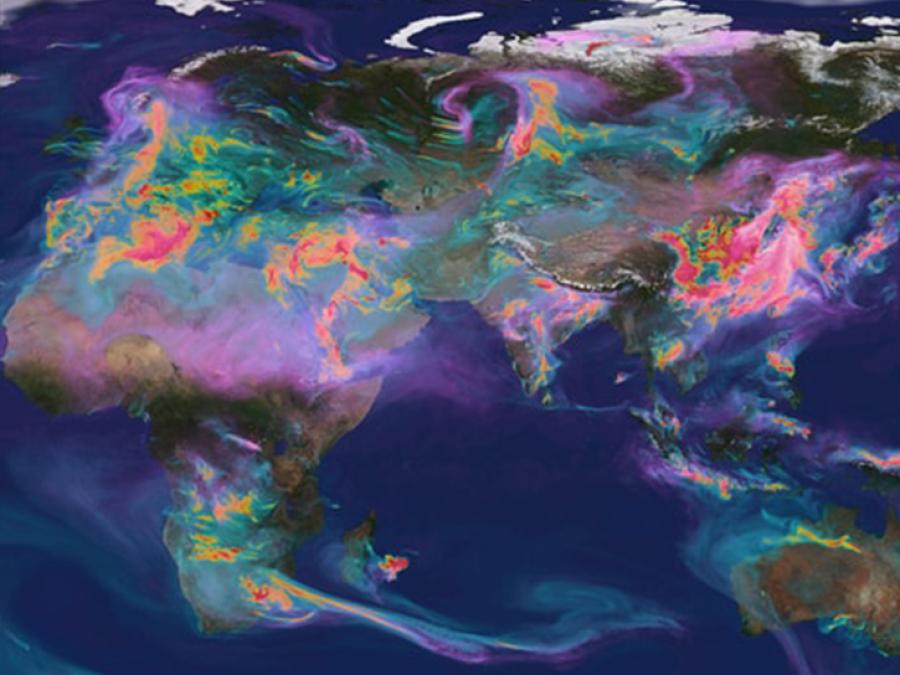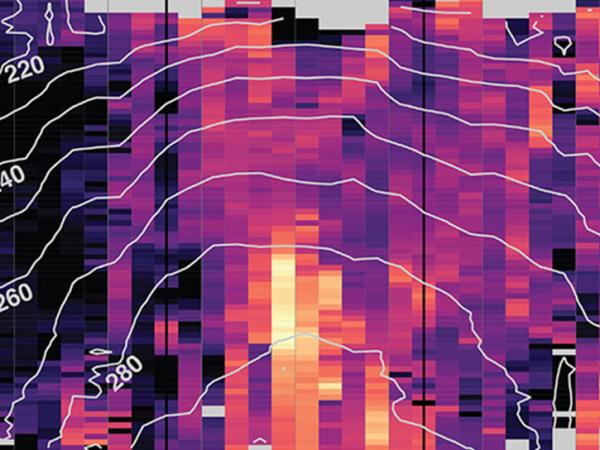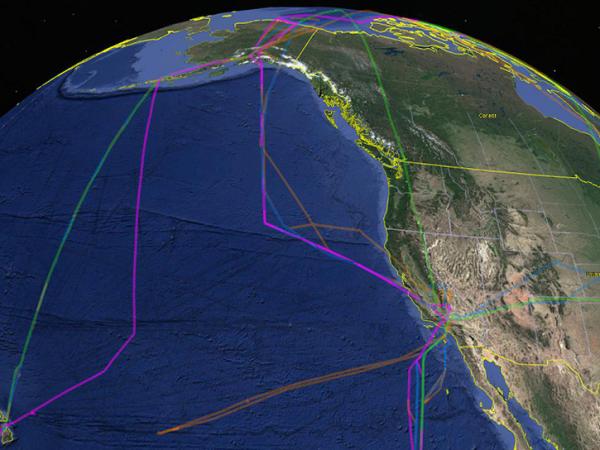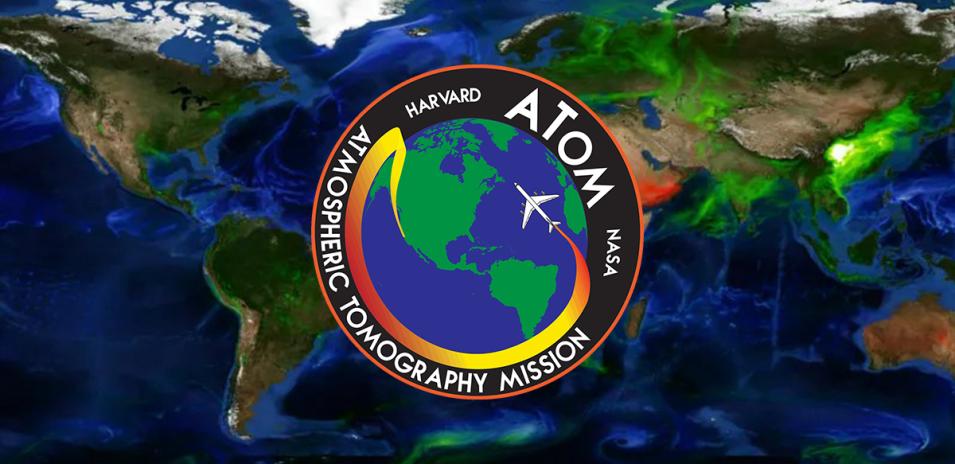| Study Dates | July 29, 2016 - May 21, 2018 |
|---|---|
| Season of Study | Year round |
| Region | Western Arctic, South Pacific, Atlantic Ocean, Greenland, Central North America |
| Spatial Bounds | N: 80°N S: 80°S W: 180°W E: 180°E |
| Focus Areas | Atmospheric Composition Carbon Cycle and Ecosystems Climate Variability and Change |
| Geophysical Concepts | Aerosols Atmospheric Chemicals and Trace Gases |
| Scientific Topics | Human-Produced Air Pollution Methane Ozone Air Quality Atmospheric Chemistry |



ATom
The Atmospheric Tomography Mission (ATom) was a NASA Earth Venture Suborbital-2 mission to study the impact of human-produced air pollution on greenhouse gases and on chemically reactive gases in the atmosphere. ATom deployed an extensive gas and aerosol payload on the NASA DC-8 aircraft for systematic, global-scale sampling of the atmosphere, profiling continuously from 0.2 to 12 km altitude. Around-the-world flights were conducted in each of four seasons between 2016 and 2018.
Principal Investigator
Data Centers
Funding Programs
Tier 1
- What are chemical processes that control the short-lived climate forcing agents CH4, O3, and BC in the atmosphere? How is the chemical reactivity of the atmosphere on a global scale affected by anthropogenic emissions? How can we improve chemistry-climate modeling of these processes?
Tier 2
- Over large, remote regions, what are the distributions of BC and other aerosols important as short-lived climate forcers? What are the sources of new particles? How rapidly do aerosols grow to CCN-active sizes? How well are these processes represented in models?
- What type of variability and spatial gradients occur over remote ocean regions for greenhouse gases (GHGs) and ozone depleting substances (ODSs)? How do the variations among air parcels help identify anthropogenic influences on photochemical reactivity, validate satellite data for these gases, and refine knowledge of sources and sinks?
The NASA DC-8 flight operations are provided by NASA /Armstrong Flight Research Center based out of Bldg 703 in Palmdale, CA. The University of North Dakota National Suborbital Education and Research Center provides science mission operations including payload integration engineering, data display and satcom systems and support, and education and outreach for the program.
The DC-8 is a four-engine jet aircraft with a range in excess of 5,000 nmi (9,200 km), a ceiling of 41,000 ft (12,500 m), and an experiment payload of 30,000 lb (13,600 kg). Utilization is planned to be 350 to 500 flight hours per year.
| Platform | Instrument(s) |
|---|---|
| Douglas DC-8 | Chemical Ionization Mass Spectrometer (NOAA-CIMS) Laser Aerosol Spectrometer (LAS) CU Aircraft High-Resolution Time-of-Flight Aerosol Mass Spectrometer (HR-AMS) Georgia Institute of Technology Chemical Ionization Mass Spectrometer (GT-CIMS) Trace Organic Gas Analyzer (TOGA) Programmable Flask Package Whole Air Sampler (PFP) Picarro Gas Analyzer Quantum Cascade Laser System (QCLS) Cloud Aerosol and Precipitation Spectrometer (CAPS) Soluble Acidic Gases and Aerosols (SAGA) Particle Analysis By Laser Mass Spectrometry (PALMS) Single Particle Soot Photometer (SP2) Airborne Tropospheric Hydrogen Oxides Sensor (ATHOS) California Insitute of Technology Chemical Ionization Mass Spectrometer (CIT-CIMS) Whole Air Sampler (WAS) PAN and Trace Hydrohalocarbon ExpeRiment (PANTHER) Aerosol Microphysical Properties (AMP) NCAR Airborne Oxygen Instrument (AO2) Nucleation-Mode Aerosol Size Spectrometer (NMASS) Charged-coupled device (CCD) Actinic Flux Spectroradiometers (CAFS) Diode Laser Hygrometer (DLH) In Situ Airborne Formaldehyde (ISAF) Chemiluminescence Instrument (NOx/NOxy) Meteorological Measurement System (MMS) Uncrewed Aircraft Systems (UAS) Chromatograph for Atmospheric Trace Species (UCATS) |
| Campaign Balloons | Ozonesonde NOAA Dual-Beam UV-Absorption Ozone Photometer (NOAA-O3) Radiosonde |
| Campaign | Upload | Deployment | Download |
|---|---|---|---|
| ATom-1 (Summer 2016) | Jun 20 - Jul 27 | Jul 28 - Aug 22 | Aug 23 - Aug 26 |
| ATom-2 (Winter 2017) | Dec 4 - Jan 27 | Jan 26 - Feb 22 | Feb 23 - Feb 25 |
| ATom-3 (Fall 2017) | Aug 14 - Sep 27 | Sep 28 - Oct 26 | Oct 27 - Oct 30 |
| ATom-4 (Spring 2018) | Mar 12 - Apr 23 | Apr 24 - May 21 | May 22 - May 25 |
- CAM-Chem (Community Atmosphere Model with Chemistry): Chemical climatology, including reactivities for typical years and time of ATom-1 flights.
- GEOS-Chem (Goddard Earth Observing System (GEOS) with Chemistry): Chemical climatology, including reactivities for typical years and time of ATom-1 flights
- GEOS-5 (Goddard Earth Observing System Model, Version 5): GEOS5 fp meteorological products interpolated to the flight track: winds, vorticity, humidity, temperature, simply specified tracers (CO, SO2, many aerosol types)
- GFDLAM3 (the atmospheric component of the GFDL coupled model CM3): Chemical climatology, including reactivities for typical years and time of ATom-1 flights
- GISSE2 (GISS series of coupled atmosphere-ocean model): Chemical climatology, including reactivities for typical years and time of ATom-1 flights
- GMI (Global Modeling Initiative): GMI full chemistry CTM hindcast: gas-phase chemistry (40 species) along 10-sec merge, interpolated to the flight track
- GMI4D (Global Modeling Initiative 4D): GMI CTM hindcast with 4D grid bounding flight path: gas-phase chemistry (40 species) at: ¼ hr, 1° latitude, 1.25° longitude, standard model levels
- GMICTM (GMI chemistry and transport model): Chemical climatology, including reactivities for typical years and time of ATom-1 flights
- UCICTM (UCI chemical transport model): Chemical climatology, including reactivities for typical years and time of ATom-1 flights
- WRF (Weather Research and Forecasting): 3D back trajectories for ATom parcels along flight path; Convective influence for ATom parcels along flight path; Boundary Layer influence for ATom parcels along flight path; Convective and Boundary Layer influences for ATom parcels along flight path
The following resources provide additional information about the ATom campaign.
